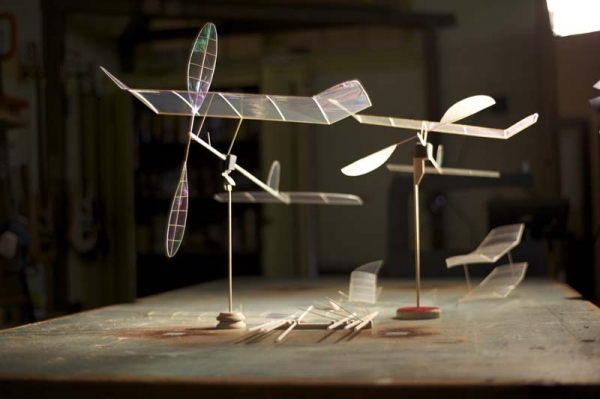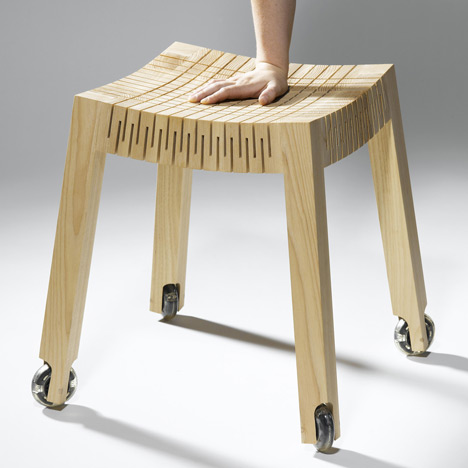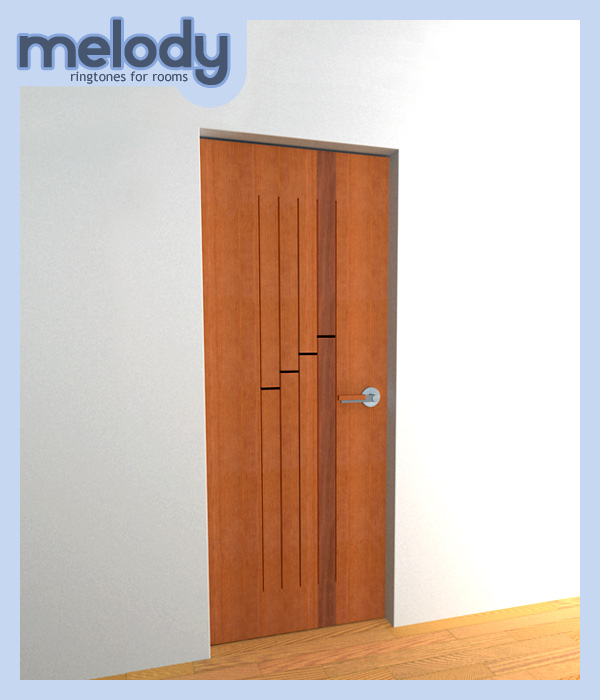First, thanks to all who gobbled up our sale items over the past week. That was fun. There are a few items still available for those of you who missed last Friday’s feeding frenzy.
As a designer, I draw upon many other disciplines for inspiration, and here are a couple that are worth sharing.
This first link is in regards to the yet to be released documentary “Float”. I cannot wait to see this film! Make sure to watch the trailer at the bottom.

A customer recently sent me this link and thought it looked familiar. I think it is awesome! I wrote to Carol to see by chance if she was influenced by our Squiggle Wood but have yet to hear back. Doesn’t matter, cool don’t you think? Click here for the movie.

What a fun idea: The Melody Door!
Designer’s own words:
The melody door brings the fun and customization of ringtones to your home. Now anyone announcing themselves with a knock can be as playful as the want to be. Ever wanted to tap out “Taps” to wake someone up in the morning? Or how about chopsticks? One full octave of notes gives you a range of choices, while the design of the door fits nicely with a modernist aesthetic. With melody your knock is as unique as you are.

Lastly, look what you can do with your tools;
I hope you are itchin’ to get back in your shop!
-John

John,
I saw that chair and thought the same thing. I wrote up my take on it here: http://www.woodzealot.com/2011/01/26/i-must-sit-on-that/ (I understand if you don’t publish this comment or remove this link if you find it inappropriate).
Interesting to see that design on that scale. Maybe someone will make a home out of Squiggle Wood one day… probably resulting in one of the more earthquake proof designs.
Course, there’s most likely a reason people don’t dabble in structural engineering and I believe I may have just proven why.
-Charles
Wow, John! How fun! Those planes are astounding. To make such a strong horizontal member to withstand the compression of the rubber band, while weighing only a gram… Amazing.
I loved that chair. Very clever idea. However, I think I’d fill the voids with a rubber compound (maybe a nice contrasting color) so that it wouldn’t pinch your butt when the gaps opened and shut. I’m still jazzed after making some squiggle wood (and squiggle dowels) at the WIA last fall. I particularly liked the squiggle pen – if only we’d had the correct-sized bit to make the hole for the pen cartridge. I was thinking it would have been cool to cut off the corners of the squiggle wood to make an octagonal cross section at the tip where you’d hold the pen.
Beautiful animation of the underwater tools. I thought the sound effects were particularly well done.
Thanks so much for sharing. I don’t have the time to search these things out on the web – it’s nice to have someone to do the work for you!
– Peter
Charles;
I think that stool is fascinating and I am attracted to the “out of the box” attitude it took to create it. It is particularly interesting to me because of the negativity propagated by the internet yahoos when they saw Squiggle Wood for the first time and blasted us for making something so worthless. There are some exciting things one could make with this concept, and I just need to find more time in my day.
I have never sat in that chair but I am willing to bet it feels good, will not pinch and most likely won’t create “waffle butt”. I really like it.
Thanks for sharing.
-John
I saw the squiggle wood thing done by a Japanese Designer for his store in San Francisco about 24 years ago or so. He had very cleverly made a calendar out of it and placed a thin piece of wood between the cuts to mark out the day. It was such a beautiful object done in the that quintessential simple Japanese manner.
He may still carry it.
Thanks John,
I love it when my theory of the whole world spending their lives updating a Facebook page is proven wrong!
Those planes are so cool; I’m fascinated by how slow they move and still stay aloft. It reminds me more of movements that would occur in water rather then air! Perhaps they might find the JMP and AMP useful in cutting out the balsa ribs for the wings!
-Rutager
Rutager;
FYI, air is a fluid. I agree, they are mesmerizing.
John
Paul;
I would love to see that calendar–do you have a link?
-John
That’s funny I thought I included the link…This is the link to the gallery/store but it seems he doesn’t do an e-commerce sort of business.
http://www.japonesquegallery.com/
So in the 90’s I remembered it when I was exploring new forms in holding my photography portfolio I cut a few of the squiggles in the middle of this..I never built the portfolio but threw this in the garden where it still resides
Can’t remember how to post up a pic..but here goes.
Click here.
Paul:
Thanks for the link.
I had my very first one-man furniture show in San Francisco in the late 70’s. Do you by chance remember the Elaine Potter Gallery? I don’t believe it still exists but back then it was really a cool, contemporary gallery.
I will visit Japonesque on my next trip to SF–looks like a great place.
-John
I arrived in SF in ’82. I don’t recall the Potter gallery.
“Air is a fluid”. Right, air is generally, simplistically, referred to as about 1/800 the density of water; visualize the relative areas of a boat’s sails and its “equal, yet opposite” underbody, reacting the wind to the water. Viscosity is a very complex measure dependent on many factors and then there’s thixotropy; kind of, roughly, the ability of a fluid to resist energy input, not really, but that’s an interesting way to think of it, I don’t know how physicists think of thixotropy of gasses, or if they do. Then there’s Reynolds Number, which is where the rubber band meets the road, when it comes to those fantastic airplanes. There isn’t “a” Reynolds number but every body moving through the air gets its own. In effect, a bumblebee’s wings experience a much denser medium than do the wings of a 747. It’s the same air, but Reynolds number sort of explains how a bee, on its scale, and a Boeing, on a vastly different scale and with crazily different mechanics, both get to fly. I can’t wait to see that movie.
Thixotropy is just one kind of non-Newtonian behavior in fluids. (Non-Newtonian fluids are those for which “viscosity” is not a well-defined concept; the apparent viscosity can change depending on time, magnitude of shear stress, etc.)
In most cases, non-Newtonian behavior is the result of either particle-particle interactions or the fact that “particle” is not a good description of the fluid’s constituents (e.g., aqueous solutions of long-chain polymers).
In gases under “reasonable” conditions of temperature and pressure, the particles are too far apart to interact in this way, and so such fluids are essentially Newtonian. A good rule of thumb is that if the gas behaves like an ideal gas, then it is also going to behave like a Newtonian fluid. Only at the extremes of low temperature or high pressure are you going to begin to see a measurable deviation.
-Steve
Thanks Steve, it’s good to hear from somebody who knows his stuff. My knowledge is very limited and I’m always glad to be corrected or to have gaps filled.
Gary
Dang Guys,
I make a simple comment and it turns into a science lesson in which I learn no fewer then 3 new words or concepts. I get smarter everytime I interact with those who post here! So for your sakes, I hope there isn’t a “intelligent equilibrium,” because if there is, you all just got dumber!
Thanks for the schooling, Rutager
Just for fun, some more on thixotropic and non-Newtonian liquids…
1) Some types of shampoo are thixotropic. You can show this by taking your CT-6 hand drill and chuck a dowel into it. Put the end of the dowel into a puddle of the shampoo, and crank. You’ll see that the shampoo climbs up the dowel!
2) Nothing is more fun (for less money) than a thick corn starch in water mixture. Its viscosity changes depending on the stress exerted on it. If you apply a sudden stress (like – hammer it, or try to pull a spoon out suddenly), it acts almost like a solid. It will fracture and break, and then slowly pool back together. Have some kids handy – they’ll love this stuff!
3) You can (if you cruise the right web sites) purchase magneto fluids – fluids that respond to a magnetic field. Deeply fun.
4) Miso soup is a particularly good medium for fluid dynamics. If you just leave it unstirred you’ll see it develop convection cells. They’ll often have a hexagonal shape as they pack into the surface of the soup.
And on another note: if anyone knows any ways of measuring viscosity on millimeter scales I’d really like to know. Especially if you can do it in the ocean…
– Peter
John,
Tonight I went a bit early to Italian class since it’s right next door to the gallery I spoke of in comment number 8. It seems the focus of the place has indeed changed from somewhat affordable items to pieces of incredible beauty and of course price.
The squiggle wood thing I spoke of is no longer there.
Grazie!
-John